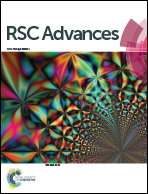A novel bioemulsifier from Geobacillus stearothermophilus A-2 and its potential application in microbial enhanced oil recovery†
Abstract
Biosurfactants can improve the mobility of oils in porous media by changing the rock wettability and emulsifying oils, thus increasing the efficiency of crude oil recovery in the petroleum industry. Therefore, surfactant-producers play important roles in the microbial enhanced oil recovery (MEOR) process. In this study, a thermophilic, facultative anaerobic emulsifier-producing strain was isolated. The emulsifier produced and its potential applications in MEOR were investigated in the laboratory. The stain was identified as Geobacillus stearothermophilus, and was designated as A-2, which could use sodium acetate, which is relative abundant in reservoirs, as the carbon source. The produced bioemulsifier is a novel glycoprotein emulsifier, containing 71.4% sugar and 27.8% protein, wherein the monosaccharides were identified as mannose (33.5%), glucose (30.9%), galactose (29.7%), and glucuronic acid (5.9%); and the protein contained 17 types of amino acids. The bioemulsifier successfully emulsified various hydrocarbons at a wide range of salinity, temperature, and pH. Notably, the emulsion layer of diesel remained stable for 12 months at room temperature, with little change at the micron level in the particle size of oil droplets. Core flooding tests indicated that the fermentation broth of strain A-2 increased the oil recovery efficiency by 6.8% under lower oil saturation condition, showing potential applications in oil exploration in high-temperature oil reservoirs.


 Please wait while we load your content...
Please wait while we load your content...